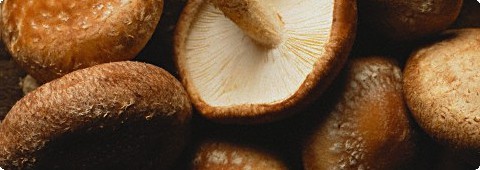Shiitake
Lentinus edodes
The origin of the name Shiitake in Japanese is – a mushroom. In light of the deep admiration and worship of this mushroom it was decided to name it “The Mushroom” and even a shrine was built in its honor. The Shiitake is used in the orient for thousands of years as a major component in the Asiatic kitchen and for healing. In 199 BC, a Japanese tribe introduced the mushroom for the first time to the Japanese emperor. However, even before that an older script described that the Chinese developed a method for cultivating the Shiitake and they had transferred this knowledge to the Japanese.
In nature the Shiitake is growing on fallen tree trunks or rotten stumps in warm and humid environments. Currently it is cultivated as a food source in South East Asia countries (1-3).
Traditional applications:
Strengthening and enhancing energy, reducing hunger and over-eating, strengthening the body while recovering from diseases, aiding undernourished children and elderly people and in treating cold and influenza.
The mushroom composition:
The Shiitake mushroom has high nutritional value either by its natural or dried form.
A dry extract of the Shiitake contain:
Carbohydrates 58-60%, nutritional fibers 10%, proteins and nucleic acids 20-23%; 80-87% of which are digestible, fatty acids 3-4% that include – linoleic acid 72.8%, palmitic acid 14.7%, oleic acid 3%.
Vitamins: The Shiitake is rich in vitamins. It contains pro-vitamin D2. It was found that while the mushroom is exposed to light and warmth it synthesizes the human derivative of Vitamin D. Vitamins of the B complex especially vitamin B1, B2, B12 and pantothenic acid (B5).
Minerals: The Shiitake is rich in iron, manganese, potassium, calcium, magnesium, zinc and more (1,3,4,5,6).
Fibers and polysaccharides:
Dry Shiitake mushroom contain 3-5% polysaccharides including glucans, especially beta –glucan that has proven medical properties, lentinan that has anti heteroglucans tumor activity and also stimulate the immune system (1,3,-8).
The polysaccharide KS-2 is extracted from the mushroom mycelium. This polysaccharide is composed from a carbohydrate that is bonded to a protein that contain the amino acids threonine, alanin, serin and proline and to the sugar Mannan. This structure stimulates the interferon levels of the body and was shown to have clinical activity against sarcoma (9).
Eritadenine:
This compound is unique to the Miitake, and act to reduce blood cholesterol levels by secreting it from the body (10).
Clinical applications:
Cancer, sarcoma, activation of the immune system, immune deficiency, AIDS, anti-bacterial, anti-viral, anti-parasitic, anti-fungi, enlarging
blood vessels, hemorrhoids, reducing cholesterol and blood lipids, protecting the liver, rehabilitating liver cells, hepatitis B.
Caution:
Patients who take Coumadin or Clexane have to start consuming small doses while testing for coagulation factors (6,11).
REFERENCES
1. Hobbs Ch. Medicinal Mushrooms: An Exploration of Tradition, Healing, and Culture. 2nd ed. Santa Cruz, CA, USA:
Botanica Press, Inc, 1995.
2. Singer R, Harris B. Mushrooms and Truffles: Botany, Cultivation, and Utilization. 2nd ed. Koenigstein: Koeltz Sci. Books, 1987.
3. Wasser SP, Weis AL. Medicinal Mushrooms. Lentinus edodes (Berk.) Singer. Haifa, Israel: Peledfus Publ. House, 1997:95.
4. Stamets P. Growing Gourmet and Medicinal Mushrooms. 3rd ed. Berkeley, CA: Ten Speed Press, 2000.
5. Mizuno T. Shiitake, Lentinus edodes: functional properties for medicinal and food purposes. Food Rev Int 1995; 11:7–21.
6. Hobbs Ch. Medicinal value of Lentinus edodes (Berk.) Sing. A literature review. Int J Med Mushr 2000; 2:287–302.
7. Yap AT, Ng ML. An improved method for the isolation of lentinan from the edible and medicinal shiitake mushroom, Lentinus edodes (Berk.)
Sing. (Agaricomycetideae). Int J Med Mushr 2001; 3:9–20.
8. Ngai PHK, Ng TB. Lentin, a novel and potent antifungal protein from shiitake mushroom with inhibitory effects on activity of human immunodeficiency virus-1 reverse transcriptase and proliferation of leukemia cells. Life Sci 2003; 73:3363–3374.
9. Fujii T, Maeda H, Suzuki K, et al. Isolation and characterization of a new antitumor polysaccharide, KS-2, extracted from culture mycelia of Lentinus edodes. J Antibiot 1978; 31:1079– 1090.
10. Yang BK, Kim DH, Jeong S, et al. Hypoglycemic effect of a Lentinus edodes exo-polymer produced from a submerged mycelial culture. Biosci Biotechnol Biochem 2002; 66:937– 942.
11. Yang QY, Jong SC. Medicinal mushrooms in China. Mushr. Sci. 1989; XII:631–642.




